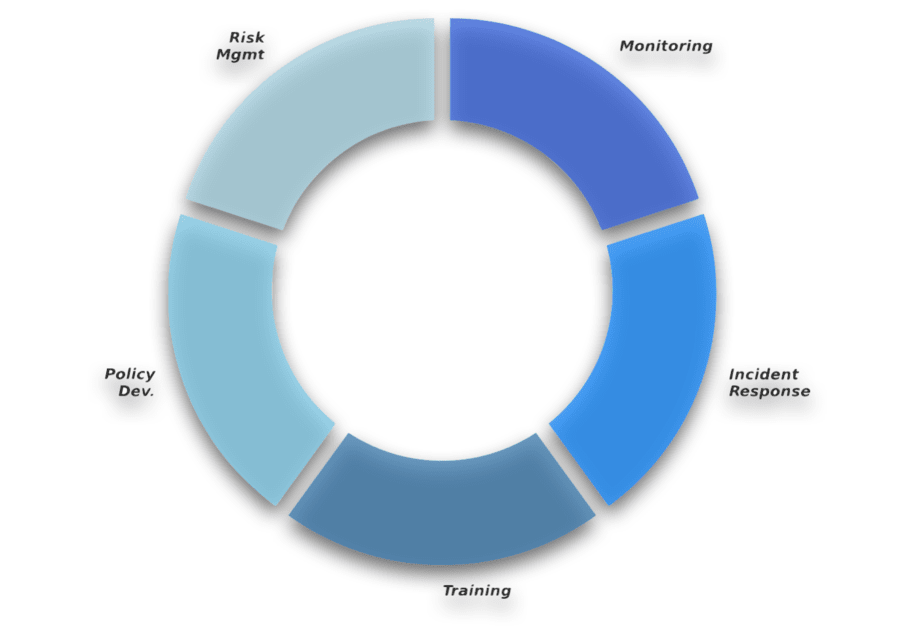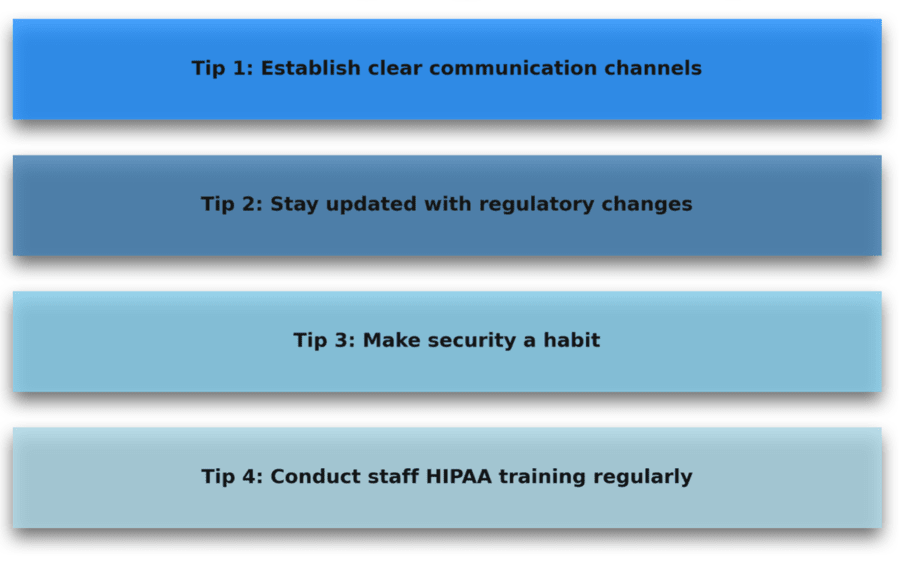In the healthcare industry, data safety standards are regulatory requirements for safeguarding electronic Protected Health Information (ePHI) and shielding organizations from rampant crime and hefty penalties. That’s why HIPAA security officers are appointed—to ensure that healthcare organizations stay on the safe and legal path, and off the breach report.
If you're tasked with overseeing HIPAA compliance, you already know it's about more than just checking boxes and delegating; it’s about understanding the problem and the infrastructure, what the HIPAA security officer responsibilities include, and helping your organization maintain an effective, fortified process.
This post is all about what it takes to be a HIPAA Security Officer, how to keep things running smoothly, and the tools that will make your life easier. We’ll throw in some direct pointers to the official standards, but we’ll keep things practical and approachable—because the HIPAA security rule and all the associated standards can seem a little daunting at first.
We strongly recommend you Download the Complete HIPAA Checklist for 2025, which also features a full overview and glossary of HIPAA, and refer to it whenever you and your staff need a refresher.
Before we start unpacking details about the role and responsibilities of a HIPAA security officer, let’s answer two fundamental questions. What is a HIPAA security officer and, can anyone be a HIPAA security officer?
What is a HIPAA Security Officer?
A HIPAA security officer is the designated individual responsible for ensuring that an organization complies with the HIPAA Security Rule, specifically focusing on protecting electronic Protected Health Information (ePHI).
This person serves as the organization's point of contact for security-related matters and sees to it that appropriate measures are in place to safeguard sensitive health and patient financial data. They are essential in helping organizations meet regulatory requirements and protect patient privacy within the healthcare industry.
This role is not to be confused with a compliance officer. The difference between a HIPAA security officer and a compliance officer is that the security officer focuses on protecting ePHI through security measures, while the compliance officer ensures the organization adheres to all laws and regulations, including HIPAA, across the entire organization.
This distinction is important because the HIPAA Security Officer's role requires a more technical understanding of data security measures, whereas the compliance officer oversees broader regulatory adherence.
Can anyone in the company be a HIPAA Security Officer?
Yes, anyone in the company can technically be appointed as a HIPAA security officer, but they need to have the necessary knowledge and skills to manage the security of ePHI. In smaller organizations, this role is often taken on by someone in IT or management, while larger organizations may designate a full-time specialist for the position.
Regardless of who it is, this person must understand HIPAA regulations, data security practices, and be capable of overseeing the organization's security measures to ensure compliance.
What does a HIPAA security officer do? What are the responsibilities of a HIPAA security officer? HIPAA security officer job description
As the designated HIPAA security officer, you’re the frontline defense for ensuring that ePHI stays private. The role is about keeping patient data safe and secure while ensuring your organization doesn’t end up on the wrong side of an audit or, worse, a data breach.
The HIPAA Security Rule lays out exactly what’s expected of you, but let’s break down the most important tasks:

1. Risk analysis and management
You need to know where your organization’s weak points are. Risk analysis is a must under 164.308(a)(1)(ii)(A), and it’s the foundation of all your security efforts. You can’t fix what you don’t know is broken, right?
Regularly assess where ePHI is vulnerable, whether that’s in your file transfer processes, on local devices, or somewhere in your network.
Here’s a tip: Use the NIST SP 800-30 framework to identify risks. This NIST standard aligns perfectly with HIPAA and offers practical steps for managing vulnerabilities.
2. Policy development and enforcement
Your policies are your frontline rules. Under 164.316(a)’s Policy and Transmission Security standards, you’re required to build and enforce security policies that cover everything from encryption standards to who gets access to ePHI.
Remember, it’s not enough to just have the policies—you need to enforce them, and that includes selecting and rolling out secure transfer and storage tools that come equipped with secure protocols. There are plenty of products to help you enforce security, and we’ll cover those later in the “Tools” section of this guide.
Here’s a tip: Make sure your policies also cover encryption of data at rest and in transit, especially for things like SFTP transfers, which are better executed through a comprehensive cloud SFTP and storage solution like SFTP To Go. Using SFTP To Go ensures you meet HIPAA standards with encrypted file transfers, multi-factor authentication (MFA) and other access controls.

3. Employee training
Let’s be real—policies are only as good as the people following them. Training your staff is not just good practice, it’s required by HIPAA’s Training standard under 164.308(a)(5).
Your team needs to understand what constitutes a breach, how to handle sensitive data, and why MFA and other access controls are non-negotiable. Regular security training sessions are essential and should never be brushed over.
Pro Tip: Use state-of-the-art compliance and security training platforms like KnowBe4 to run simulated phishing attacks. It’s a great way to keep your team sharp on identifying cyber threats.
4. Incident response
Breaches happen, even with the best policies in place. Your job is to ensure you have a response plan that includes investigating the breach, notifying the right people, and making sure the breach doesn’t happen again. HIPAA’s Incident Response standard under 164.308(a)(6) requires this.
When things go south, having a solid incident response plan can save the day.
5. Continuous monitoring and auditing
You’re not done after setting everything up. Continuous monitoring and regular auditing are your best bet to ensure nothing slips through the cracks.
HIPAA requires audit trails in its Audit Trails standard under 164.312(b), and tools like SFTP To Go provide detailed audit logs and histories of all file transfers, with detailed filters to check on individual users and individual event—golden in the event of compliance and forensic investigations.
Practical tips for effective HIPAA security management — HIPAA security officer tips
You know what needs to be done, but how do you stay on top of it all? Here are some tips to help keep your head above water while you manage that long list of HIPAA security requirements:

Establish clear communication channels
Ensure staff can easily report issues, whether it's a potential phishing email or suspicious activity. Open communication helps catch problems before they grow into catastrophes.
Stay updated with regulatory changes
HIPAA isn’t static, so neither should you be. Subscribe to updates from the HHS Office for Civil Rights to stay informed about changes that could affect your compliance strategy. State law amendments affect HIPAA on a regular basis, though HIPAA laws are only subject to local changes when those changes call for more stringent security measures.
Make security a habit
Create a security-first mindset across your organization and make staff aware that this is not a topic to be underplayed but a central tenet of your mission. The truth is, HIPAA breaches put organizations, employees, and patients at risk.
Conduct staff HIPAA training regularly
Keep training short, focused, and frequent. It’s easier for people to digest and keeps cybersecurity front of mind. An important part of this training is onboarding and refresher courses on the correct use of software and platforms like SFTP To Go.

Essential tools for HIPAA security officers
We’ve mentioned a number of tools in our tips for each section because nothing streamlines a process like the right tools. The following list, however, covers the five tools that we feel are really essential to the process.
- Get a HIPAA checklist - A comprehensive HIPAA checklist can be a go-to resource for you and the people you train, and it’s an essential that will keep you organized and progressing. Our checklist provides a full clarification of HIPAA, including a glossary and an explanation of all the HIPAA rules. Download the Complete HIPAA Checklist for 2025 for free and take the next step towards securing your organization’s future.
- Use a secure cloud transfer and storage solution– We recommend using a fortified cloud solution so you can share, store, and integrate securely with your network of internal departments and external business associates (BAs). SFTP To Go is a HIPAA-focused platform, with encrypted transfer and storage, stringent access controls, and audit logging, that will help you tick off a number of those HIPAA checklist boxes all at once. Explore SFTP automation.
- Get compliance software – You can simplify your compliance efforts with compliance management software and comprehensive solutions like TrustCloud. These solutions generally guide you through audits, training, onboarding, offboarding, fault handling, and risk assessments, automating much of the heavy lifting for you and your healthcare organization.
- Try the NIST framework and the NIST HIPAA Security Risk Assessment Tool - Regular risk assessments are a cornerstone of the HIPAA Security Rule. This free tool helps you conduct a thorough risk assessment under the highly credible NIST framework, identifying vulnerabilities and ensuring you meet 164.308(a)(1) risk management requirements.
- Outsource for regular pen testing – Regular risk assessments help uncover vulnerabilities in your infrastructure, but penetration testing offers an external review of your security posture. Organizations often hire third-party cybersecurity firms for pen testing, bringing an unbiased evaluation of security defenses. These tests validate your internal efforts and highlight gaps that might otherwise be missed.
- Make use of security management, monitoring, and response tools - Depending on your infrastructure's size and setup, you'll likely need systems to manage and monitor security for both on-premise and cloud environments. These solutions usually handle logging, monitoring, and compliance, and often come with disaster recovery built-in. Many also use AI/ML to boost threat detection and automate responses, making it easier for HIPAA Security Officers to keep an eye on everything.
In conclusion
Being a HIPAA Security Officer isn’t a walk on the beach, but with the right tools and strategies, you can confidently safeguard ePHI and be the living legend that helps to keep your organization compliant.
Whether it’s risk management, employee training, or ensuring secure file transfers, you have the power to lead your organization’s security efforts in a practical, approachable way—approachable but effective, that’s the best way to lead the HIPAA charge.
We strongly recommend you Download the Complete HIPAA Checklist for 2025, which also features a full overview and glossary of HIPAA, and refer to it whenever you and your staff need a refresher.
The checklist is all about subduing those lofty HIPAA terms so that you and your staff can see that it’s not as challenging as you may think to stay on the right side of the law and keep your patient records safe.
Frequently Asked Questions
What is the role of a HIPAA Security Officer?
A HIPAA Security Officer is responsible for ensuring the protection of electronic Protected Health Information (ePHI) through security policies, risk management, and monitoring compliance with the HIPAA Security Rule.
What is the difference between a HIPAA Security Officer and a HIPAA Privacy Officer?
A HIPAA Security Officer focuses on safeguarding ePHI and managing security measures, while a HIPAA Privacy Officer oversees the overall protection of all forms of PHI (electronic, paper, and verbal), ensuring compliance with the HIPAA Privacy Rule.
Does every organization need a HIPAA Security Officer?
Yes, every covered entity and business associate handling ePHI is required to designate a HIPAA Security Officer to ensure compliance with the HIPAA Security Rule.
Can a HIPAA Security Officer be the same person as a Privacy Officer?
Yes, in smaller organizations, the same individual can serve as both the HIPAA Security Officer and the Privacy Officer, though in larger organizations these roles are typically separate due to their different focuses.
How does a HIPAA Security Officer ensure compliance?
A HIPAA Security Officer ensures compliance by conducting risk assessments, implementing security controls, managing incident response, and regularly monitoring systems to safeguard ePHI.
Do HIPAA Security Officers need special training?
While there is no specific certification required, HIPAA Security Officers must have knowledge of HIPAA regulations, data security practices, and risk management to perform their duties effectively.
How often should HIPAA Security Officers perform risk assessments?
HIPAA requires regular risk assessments, typically annually or whenever there are significant changes to the organization’s systems or processes that affect ePHI.
What tools do HIPAA Security Officers use?
HIPAA Security Officers use tools like encryption software, secure file transfer solutions (e.g., SFTP To Go), and compliance management platforms to protect ePHI and maintain security standards.

